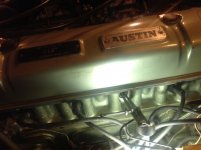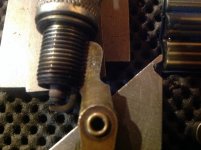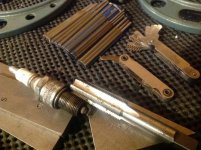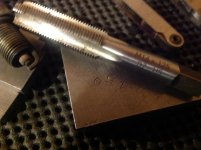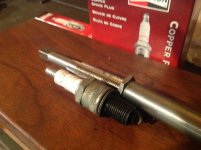RestoreThemAll
Jedi Warrior
Offline
I have no wish to spark a spark plug brand war. 
From my lurking around the BCF I noticed that several trusted BCF members use NGK BP6ES spark plugs so I bought some for my stock BJ7. The new plugs fit loose, even sloppy all the way to the washer seal. The head was completely rebuilt by a machinist and has yet to be run.
The Bentley book shows the spec at 14mm threads. I figured out that means the plug width. I used a set of calipers to examine the new plugs and they measure 3.78mm a difference of .22mm from spec. Being a back yard mechanic I don't have a good way to measure the spark plug hole. Any suggestions?
Is the difference of .22mm something to be concerned about? The sheetrock wall in the garage should slow the plugs down some, if they miss my head, when they blow out. layful:
layful:
The TPI on the new plugs measure 20 TPI or 1.25mm TPI. That seems to be correct.
Not that it really matters but why are the plugs specs in mm? I don't recall any other metric specs.
From my lurking around the BCF I noticed that several trusted BCF members use NGK BP6ES spark plugs so I bought some for my stock BJ7. The new plugs fit loose, even sloppy all the way to the washer seal. The head was completely rebuilt by a machinist and has yet to be run.
The Bentley book shows the spec at 14mm threads. I figured out that means the plug width. I used a set of calipers to examine the new plugs and they measure 3.78mm a difference of .22mm from spec. Being a back yard mechanic I don't have a good way to measure the spark plug hole. Any suggestions?
Is the difference of .22mm something to be concerned about? The sheetrock wall in the garage should slow the plugs down some, if they miss my head, when they blow out.
The TPI on the new plugs measure 20 TPI or 1.25mm TPI. That seems to be correct.
Not that it really matters but why are the plugs specs in mm? I don't recall any other metric specs.

 Hi Guest!
Hi Guest!

 smilie in place of the real @
smilie in place of the real @
 Pretty Please - add it to our Events forum(s) and add to the calendar! >>
Pretty Please - add it to our Events forum(s) and add to the calendar! >> 




